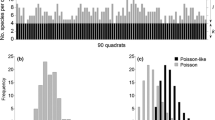Summary
A simple mathematical model describing the species-area relation was developed. This paper dealt with the case that discrete random samples are combined.
Modelling was made on the assumption that the occurrence probability of a species in a quadrat has a continuous density distribution. The model, given by the equation (6), holds only for a particular size of quadrat (i.e. the characteristic area). More general form applicable to the quadrats the size of which is near to the characteristic area was represented by the equation (9).
Validity of the model was examined for the data of plant and insect communities, and it was concluded that the observation can be predicted by the model unless the size of sampling unit considerably differs from the characteristic area.
The uniformity of specific density (i. e. the number of species per quadrat) and the size of characteristic area were discussed as being important in an understanding of community structure.
Similar content being viewed by others
References
Archibald, E. E. A. (1949) The specific character of plant communities. I. Herbaceous communities.J. Ecol. 37: 260–273.
Corbet, A. S. (1942) The distribution of butterflies in the Malay Peninsula.Proc. R. Ent. Soc. Lond. (A) 16: 101–116. (Cited fromWilliams 1964)
Feller, W. (1957)An introduction to probability theory and its applications. Vol. 1, (2nd ed.) Wiley, New York.
Goodall, D. W. (1952) Quantitative aspect of plant distribution.Biol. Rev. 27: 194–245.
Greig-Smith, P. (1964)Quantitative plant ecology. (2nd ed.) Butterworths, London.
Hopkins, B. (1955) The species-area relation of plant communities.J. Ecol. 43: 409–426.
Katô, M., S. Kobayashi andY. Chiba (1968) Forest floor insect fauna of the Mt. Hakkôda area surveyed by means of the baited traps.Ann. Rep. JIBP-CTS for 1967, 173–194. (In Japanese with English summary).
Kilburn, P. D. (1966) Analysis of the species-area relation.Ecology 47: 831–843.
Motomura, I. (1935) Relation between the area of sampling and the number of species in the animal association.Ecol. Rev. 1: 195–199. (In Japanese)
Numata, M. (1950) Survey methods and forms of the species-area relation.,Med. Biol. 17: 258–261. (In Japanese)
Orians, G. H. andM. F. Willson (1964) Interspecific territories of birds.Ecology 45: 736–745.
Penfound, W. T. andJ. A. Howard (1940) A phytosociological study of an evergreen oak forest in the vicinity of New Orleans, Louisiana.Amer. Midl. Nat.,23: 165–174. (Cited fromRice andKelting, 1955)
Preston, F. W. (1960) Time and space and the variation of species.Ecology 41: 611–627.
Preston, F. W. (1962) The canonical distribution of commonness and rarity.Ecology 43: 185–215 and 410–432.
Rice E. L. andR. W. Kelting (1955) The species-area curve.Ecology 36: 7–11.
Shinozaki K. (1963) Note on the species-area curve.Proc. Ann. Meet. Ecol. Soc. Jap. (Tokyo): 5. (In Japanese)
Williams, C. B. (1950) The application of the logarithmic series to the frequency of occurrence of plant species in quadrats.J. Ecol. 38: 107–138.
Williams, C. B. (1964)Patterns in the balance of nature. Academic Press, London.
Wynne-Edwards V. C. (1962)Animal dispersion in relation to social behaviour, Oliver and Boyd, Edinburgh.
Author information
Authors and Affiliations
Additional information
Contributions from JIBP-CT No. 144.
An erratum to this article is available at http://dx.doi.org/10.1007/BF02514088.
Rights and permissions
About this article
Cite this article
Kobayashi, S. The species-area relation I. A model for discrete sampling. Res Popul Ecol 15, 223–237 (1973). https://doi.org/10.1007/BF02510669
Issue Date:
DOI: https://doi.org/10.1007/BF02510669




